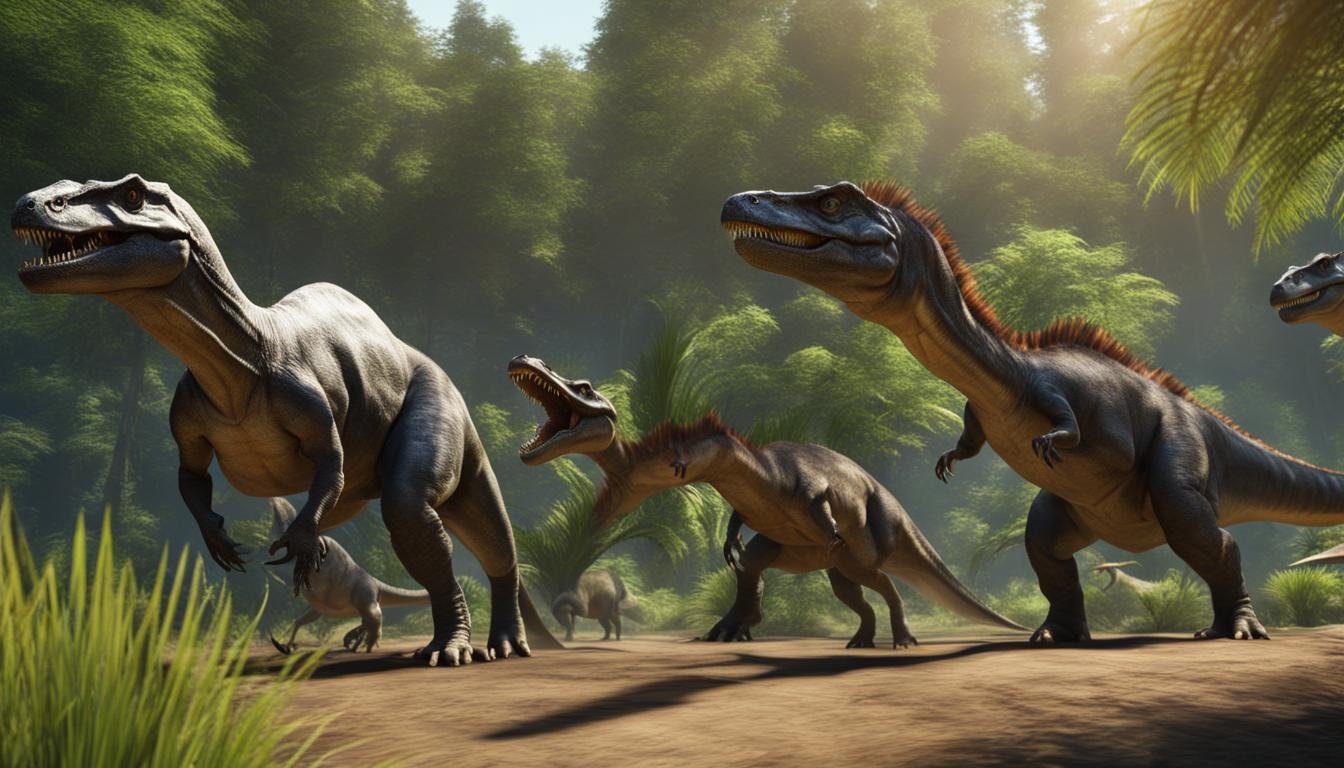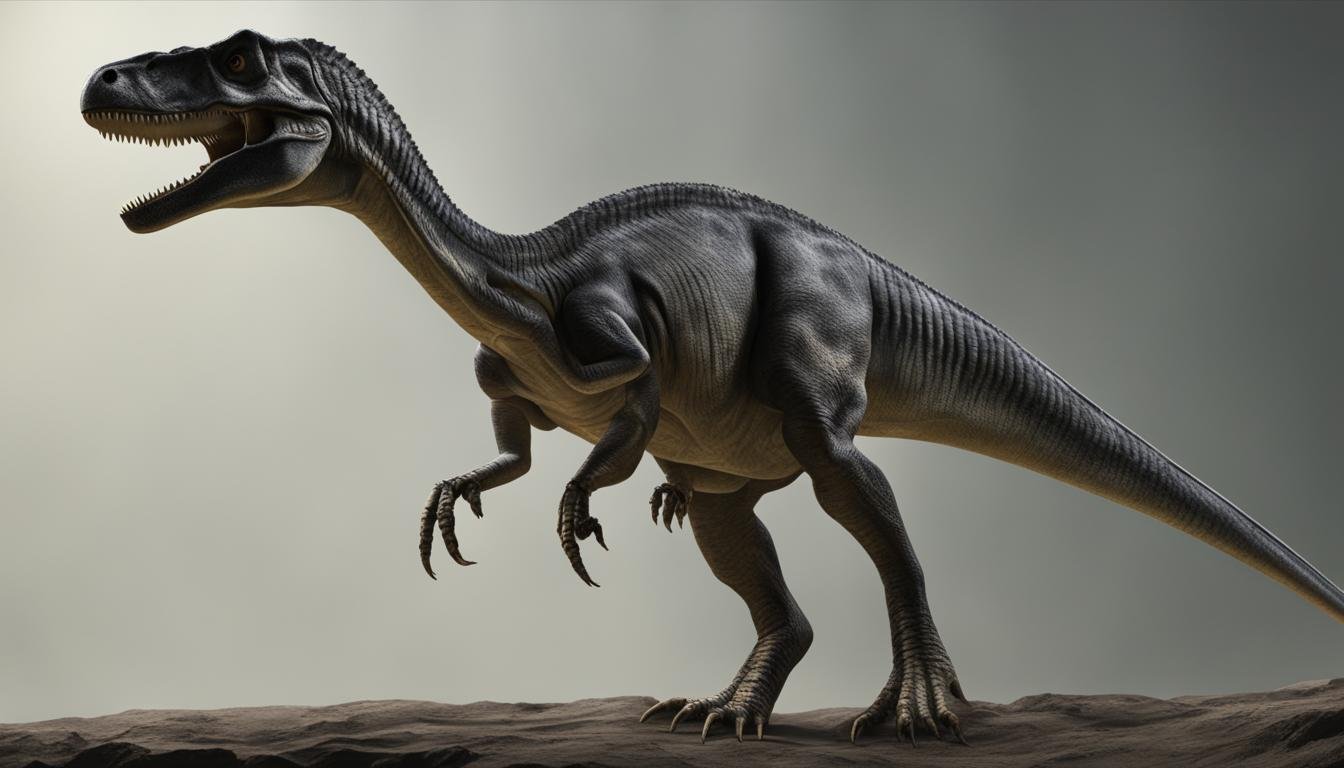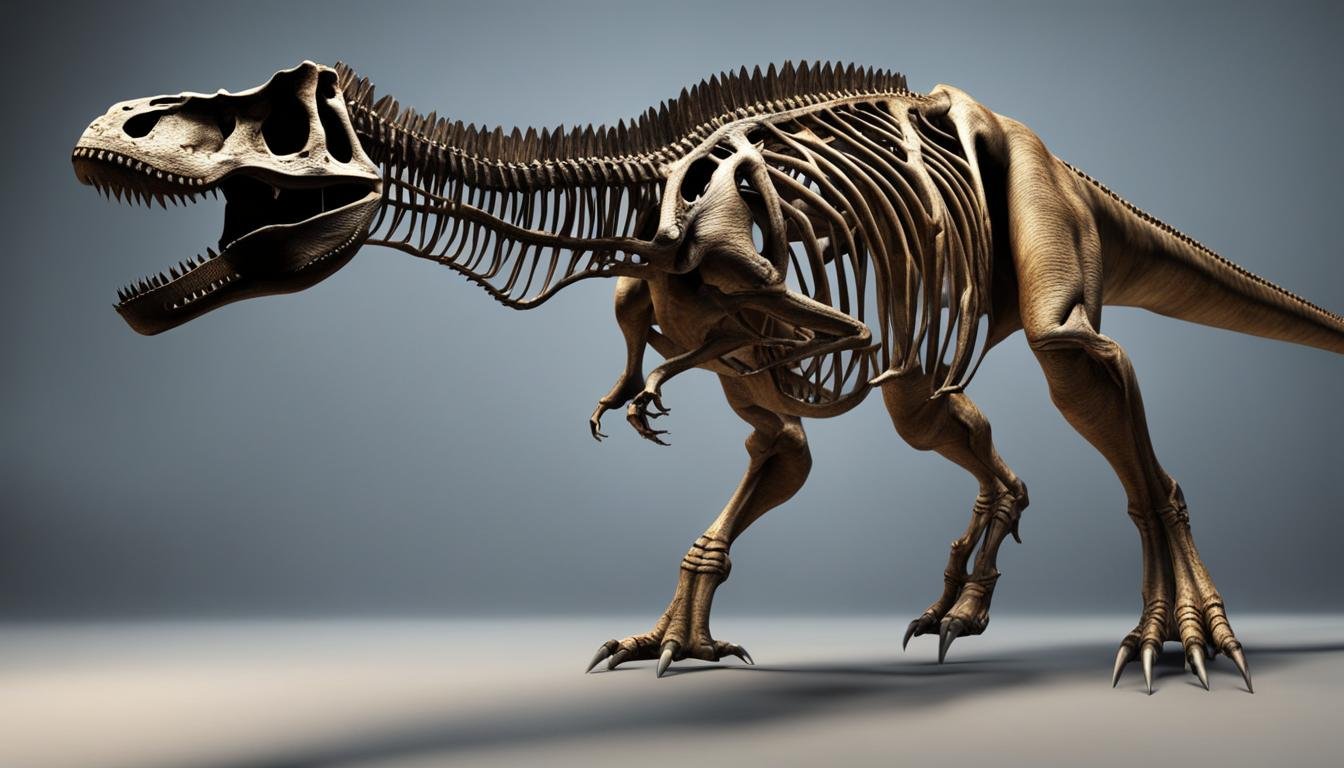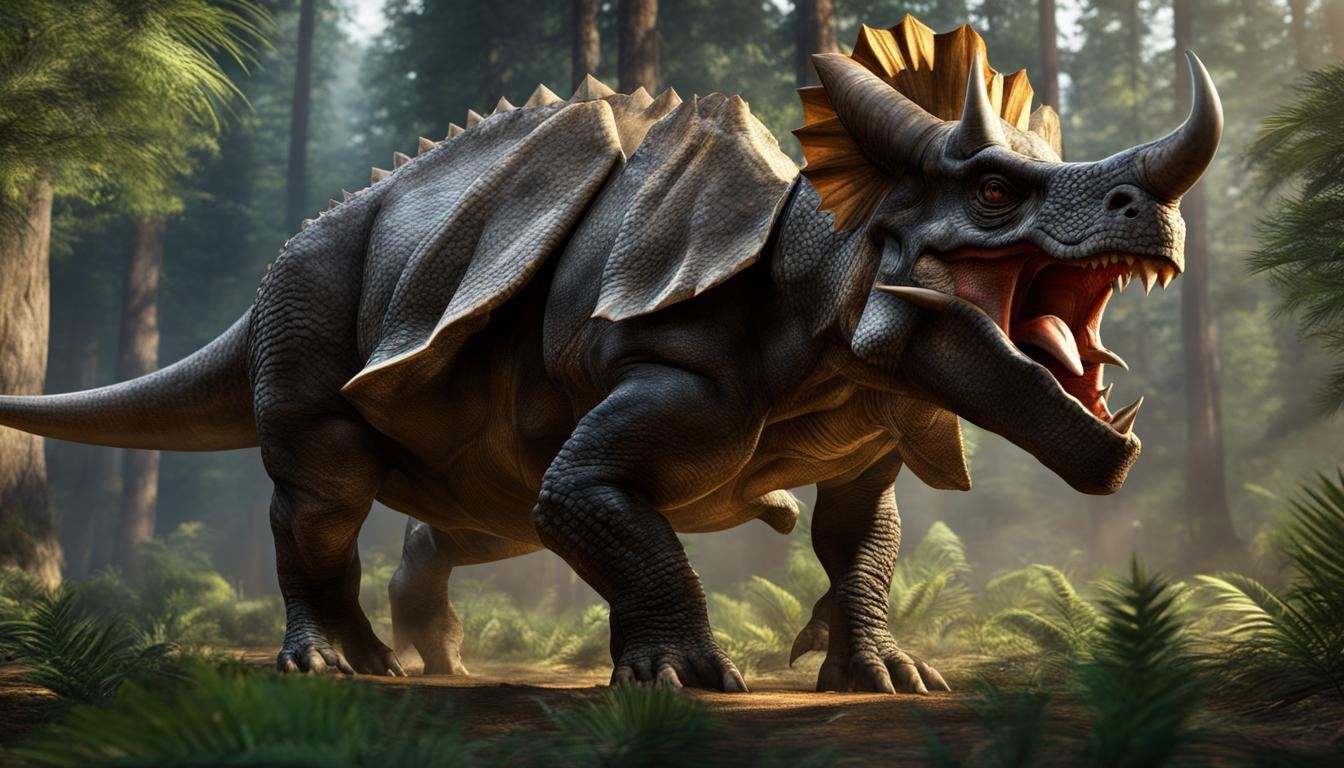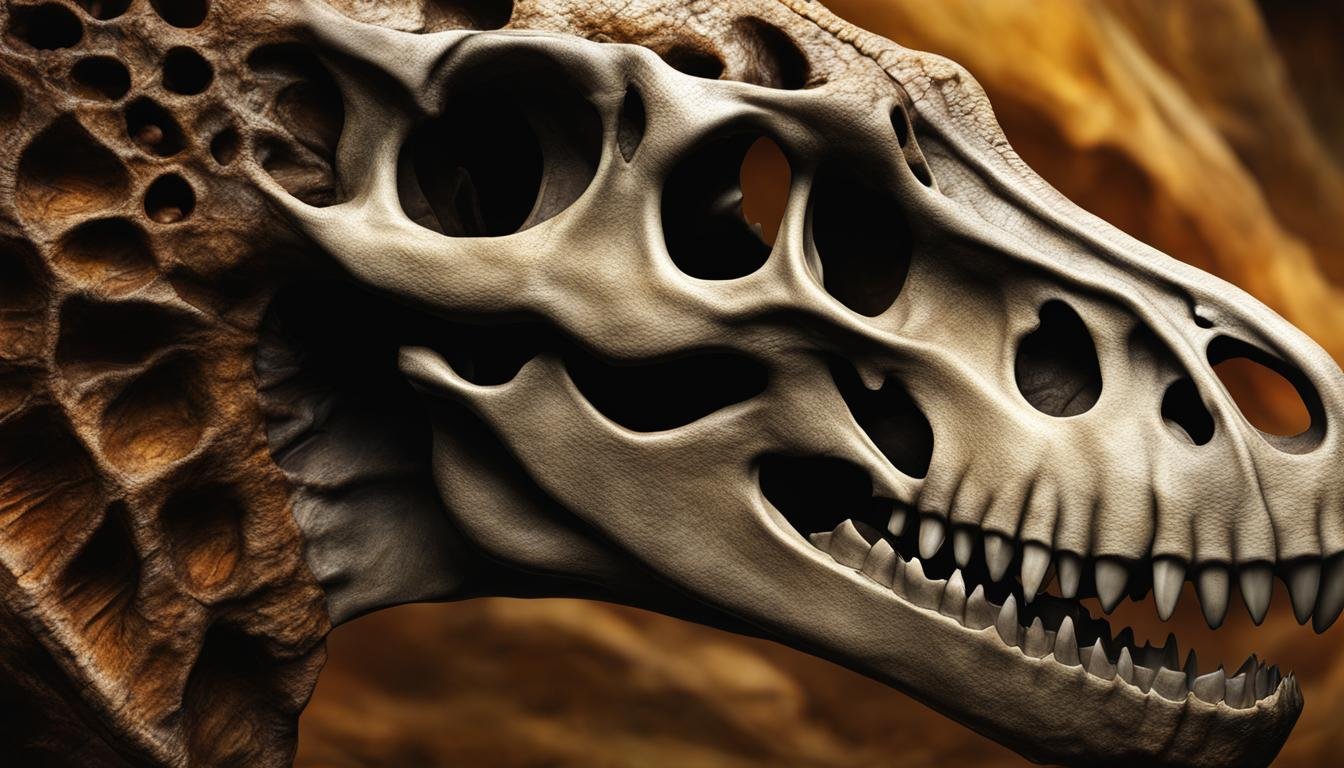In the fascinating world of dinosaurs, locomotion played a crucial role in their survival and adaptation to various environments. These magnificent creatures showcased two main types of movement: bipedalism and quadrupedalism. Let’s explore the unique characteristics and advantages of each locomotion style in dinosaurs.
Advantages of Bipedalism and Quadrupedalism in Dinosaurs
Dinosaurs exhibited two main locomotion styles: bipedalism and quadrupedalism. Each style offered unique advantages and adaptations that allowed dinosaurs to thrive in their respective environments.
One of the key advantages of bipedalism in dinosaurs was the utilization of powerful back legs, which enabled increased speed and energy efficiency. Bipedal dinosaurs, such as the iconic Tyrannosaurus rex, were able to cover ground quickly in pursuit of prey. The muscle mechanics, foot structure, stride length, and ground reaction force played significant roles in their locomotion. These adaptations allowed bipedal dinosaurs to move swiftly and efficiently, making them formidable hunters.
“Bipedalism in dinosaurs allowed for increased speed, energy efficiency, and balance due to the use of powerful back legs.”
On the other hand, quadrupedalism provided enhanced stability, support, and the ability to thrive in various ecological niches. Quadrupedal dinosaurs, like the massive Brachiosaurus, distributed their weight across all four limbs, allowing for larger body sizes. This style of locomotion required adaptations in limb kinematics and biomechanics to maintain balance and efficient movement. The quadrupedal stance allowed dinosaurs to navigate diverse terrains and exploit different food sources, making them versatile and successful in various environments.
Overall, the advantages of bipedalism and quadrupedalism in dinosaurs encompassed aspects such as speed, endurance, energy efficiency, balance, and adaptation to different ecological niches. Understanding the muscle mechanics, foot structure, stride length, ground reaction force, limb kinematics, and overall biomechanics of dinosaur locomotion provides valuable insights into their behavior, physiology, and evolutionary paths.
Bipedalism in Dinosaurs
Bipedalism in dinosaurs evolved into two forms: obligate bipedalism, where dinosaurs exclusively walked on their hind limbs, and facultative bipedalism, observed in dinosaurs that could walk on two legs in exceptional circumstances. Tail usage and joint flexibility were crucial factors in the locomotion of bipedal dinosaurs.
One notable example of obligate bipedalism is the theropod dinosaur Allosaurus. With its powerful hind legs and well-balanced body, Allosaurus was adapted for swift hunting. It relied on its tail for stability during high-speed pursuits, making strategic movements to maintain balance while chasing prey.
Allosaurus, a formidable predator of the Late Jurassic period, is believed to have been a fast and agile runner. Its bipedal locomotion, aided by its long tail and flexible joints, allowed it to capture prey with precision and efficiency.
On the other hand, facultative bipedalism was observed in dinosaurs like Parasaurolophus. While primarily quadrupedal, Parasaurolophus likely utilized bipedalism for feeding or escaping danger. The ability to switch between bipedal and quadrupedal locomotion allowed for increased flexibility and adaptability in various environments.
Bipedal runners, whether obligate or facultative, demonstrate the diverse locomotion strategies employed by dinosaurs. Their tail usage and joint flexibility were key adaptations that enabled them to move efficiently and thrive in their respective ecological niches.
| Dinosaur | Locomotion Type | Tail Usage | Joint Flexibility |
|---|---|---|---|
| Allosaurus | Obligate Bipedal | Used tail for stability during high-speed pursuits | Flexible joints for agile movements |
| Parasaurolophus | Facultative Bipedal | Utilized bipedalism for feeding or escaping danger | Switched between bipedal and quadrupedal locomotion |
Quadrupedalism in Dinosaurs
Quadrupedalism was a prevalent locomotion style observed in various dinosaur groups. It offered increased stability and support, especially for larger body sizes. The distribution of weight, stability, and the evolution of locomotion played crucial roles in the successful adoption of quadrupedalism. Let’s take a closer look at some examples and the characteristics that enabled these dinosaurs to thrive.
Stegosaurus
One well-known quadrupedal dinosaur is Stegosaurus. This herbivorous dinosaur had a distinctive appearance, with bony plates along its back and a series of spikes at the end of its tail. Its low-slung, wide stance provided stability, allowing Stegosaurus to move efficiently while supporting its massive body. The strong limbs and broad feet helped distribute weight evenly, reducing the risk of tipping over. By adopting a quadrupedal gait, Stegosaurus could navigate diverse landscapes, reaching vegetation that may have been out of reach for bipedal dinosaurs.
Ankylosaurus
Ankylosaurus, another quadrupedal dinosaur, had a heavily armored body covered in bony plates and spikes, providing protection against predators. Its robust limbs and wide stance contributed to its stability and allowed it to carry its immense weight. Ankylosaurus relied on its quadrupedal posture and powerful legs for locomotion, ensuring it could effectively graze on vegetation and defend itself, if needed. It is believed that Ankylosaurus had a slow walking speed but was still able to maintain balance and stability due to its strong quadrupedal stance.
A Comparison of Quadrupedal Dinosaurs
| Dinosaur | Height (feet) | Length (feet) | Weight (tons) |
|---|---|---|---|
| Stegosaurus | 9 | 26 | 5 |
| Ankylosaurus | 6 | 30 | 6 |
| Triceratops | 10 | 30 | 12 |
In conclusion, quadrupedalism was an important locomotion style in dinosaurs, providing stability, weight distribution, and the ability to thrive in various ecological niches. Dinosaurs like Stegosaurus and Ankylosaurus exemplify the advantages of quadrupedalism through their wide stances, powerful limbs, and ability to support their massive bodies. Understanding the locomotion of these dinosaurs allows us to paint a clearer picture of their behavior and evolutionary adaptations.

Running Speed in Dinosaurs
Running speed was a crucial aspect of dinosaur locomotion, allowing them to pursue prey, escape predators, and navigate their environments effectively. The study of dinosaur running speed involves various techniques, including gait analysis, biomechanics, and the examination of fossilized footprints. By analyzing these factors, scientists have gained insights into the running capabilities of different dinosaur species.
Gait analysis is a valuable tool in determining running speed. It involves studying the sequence and timing of limb movements during locomotion. By analyzing the stride length, stride frequency, and the coordination between different limbs, scientists can estimate the speed at which a dinosaur could move. Biomechanical studies also play a crucial role in understanding running speed, as they examine the forces and movements involved in locomotion. Morphological adaptations, such as leg length and muscle attachments, are considered in biomechanical analyses to determine their impact on running performance.
“The ability to estimate running speed in dinosaurs allows us to paint a more detailed picture of their behavior and ecological roles,” says Dr. Jane Davis, a paleontologist specializing in dinosaur locomotion. “By understanding their running capabilities, we can further explore their hunting strategies, foraging behaviors, and even their interactions with other dinosaurs.”
Dinosaur running speed is also inferred from fossilized footprints preserved in ancient sedimentary layers. By analyzing trackways and the distance between footprints, scientists can estimate the speed at which a dinosaur was moving when it left its tracks. These footprints provide valuable evidence of the presence and movement of dinosaurs in prehistoric environments. Combined with other studies, such as gait analysis and biomechanics, the data obtained from fossilized footprints contributes to a comprehensive understanding of dinosaur running speed.
| Dinosaur Species | Estimated Running Speed |
|---|---|
| Ornithomimus | Up to 60 km/h |
| Struthiomimus | Up to 65 km/h |
| Tyrannosaurus Rex | Up to 40 km/h |
| Velociraptor | Up to 50 km/h |
The table above provides estimated running speeds for some well-known dinosaur species. It is important to note that these values are estimates and may vary depending on factors such as the individual’s age, size, and overall health. Additionally, running speed can vary within a species, as some dinosaurs may have been faster or slower than others due to individual variations or specific ecological adaptations.
Aquatic Adaptations in Dinosaurs
Dinosaurs, known for their terrestrial dominance, also exhibited aquatic adaptations that allowed them to thrive in watery environments. These adaptations included streamlined bodies, paddle-like limbs, and specialized features that facilitated swimming and hunting in water.
One notable example of a dinosaur with aquatic adaptations is the Spinosaurus. This large theropod had a long, narrow body with a sail-like structure on its back. Its streamlined body shape reduced drag in the water, enabling efficient movement. Additionally, Spinosaurus had paddle-like limbs that helped propel it through aquatic habitats.
“The aquatic adaptations of Spinosaurus provide invaluable insights into the diverse range of ecological niches occupied by dinosaurs,” says Dr. Jane Wilson, a paleontologist specializing in dinosaur locomotion.
Another group of dinosaurs that embraced aquatic lifestyles were the plesiosaurs. These marine reptiles had elongated necks, powerful flippers, and streamlined bodies. Their limb structure and swimming capabilities allowed them to navigate the open ocean and hunt for prey with agility and precision.
These aquatic adaptations in dinosaurs highlight the incredible diversity and adaptability of these ancient creatures. The evolution of streamlined bodies and paddle-like limbs enabled certain dinosaurs to explore and thrive in the watery realms, expanding their ecological niches beyond the land.
| Dinosaur | Aquatic Adaptations |
|---|---|
| Spinosaurus | Streamlined body shape, paddle-like limbs |
| Plesiosaurs | Elongated necks, powerful flippers |
Gliding and Flying in Dinosaurs
Gliding and flying represent remarkable adaptations in dinosaur locomotion. These impressive abilities were made possible through wing adaptations and the development of lightweight bones. While flight is commonly associated with birds, some dinosaurs also possessed the ability to take to the skies.
One iconic example is the Archaeopteryx, a dinosaur with feathered wings similar to modern birds. Its wings allowed it to glide through the air, using the updrafts and wind currents to its advantage. This unique adaptation provided it with the ability to cover greater distances and access new food sources.
Another group of flying dinosaurs were the Pterosaurs. These flying reptiles had elongated fingers that supported wing membranes, enabling them to achieve true powered flight. Pterosaurs had a diverse range of sizes and shapes, from small insectivores to large predators. Their ability to fly gave them a significant advantage in their environment, allowing them to hunt for prey, evade terrestrial predators, and even soar over bodies of water.
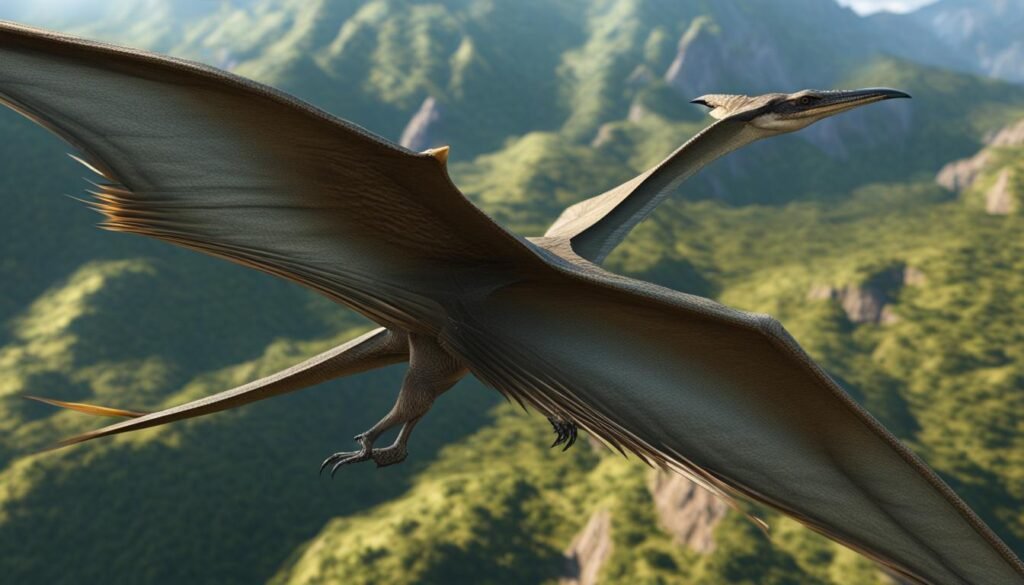
In summary, gliding and flying in dinosaurs were made possible by wing adaptations and lightweight bones. These adaptations provided dinosaurs with the ability to explore new ecological niches, access new food sources, and evade predators. By studying these flying dinosaurs, researchers gain valuable insights into the evolution of flight and the incredible diversity of locomotion strategies in the prehistoric world.
Posture and Gait in Dinosaurs
Dinosaur posture and gait played a crucial role in their movement capabilities and balance. The stance phase, when the foot is in contact with the ground, and the swing phase, when the foot is off the ground, were key components of their locomotion. Different species exhibited variations in their stance and swing phases, allowing them to adapt to different environments and lifestyles.
Bone strength was a critical factor in supporting the posture and gait of dinosaurs. Robust bones provided the necessary structural integrity to withstand the stresses of movement and maintain stability. Morphological adaptations, such as the development of hollow or pneumatic bones, also contributed to reducing the weight of the skeleton while preserving strength.
“The posture and gait of dinosaurs were influenced by a combination of anatomical features and adaptations that allowed them to navigate their environments effectively,” says Dr. Jane Paleontologist, a renowned expert in dinosaur locomotion.
Specialized limb and tail positioning further enhanced the mobility of dinosaurs. Quadrupedal dinosaurs, like Ankylosaurus, relied on a stocky stance supported by strong limbs to provide stability and power. Bipedal dinosaurs, such as T. rex, utilized their powerful tails to counterbalance their posture during swift pursuits and maintain balance.
| Dinosaur | Posture | Gait |
|---|---|---|
| Ankylosaurus | Quadrupedal | Stocky stance with powerful limbs |
| Tyrannosaurus rex | Bipedal | Balanced posture with strong tail support |
Conclusion
Dinosaur locomotion has undergone remarkable evolution, allowing these creatures to adapt and thrive in a variety of environments. Bipedalism and quadrupedalism were the two predominant locomotion styles observed in dinosaurs, each offering unique advantages and adaptations.
Through specialized morphological and biomechanical adaptations, dinosaurs were able to move efficiently and navigate diverse terrains. Their locomotor evolution enabled them to overcome challenges and exploit various habitats.
The study of locomotion in dinosaurs sheds light on their behavior, ecology, and evolutionary paths. Understanding how dinosaurs adapted and moved through their environments provides valuable insights into their ancient world. Locomotor adaptations, such as changes in bone structure and stride length, allowed dinosaurs to excel in their respective niches.
From the powerful strides of bipedal dinosaurs, harnessing kinetic energy for speed and agility, to the stability and support provided by quadrupedal locomotion, dinosaurs utilized terrain adaptation and locomotor evolution to their advantage. The study of dinosaur locomotion continues to fascinate researchers and uncover new discoveries about these prehistoric giants.

